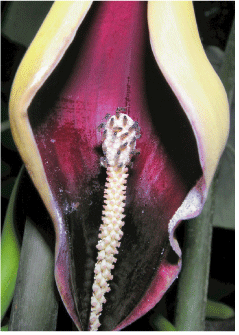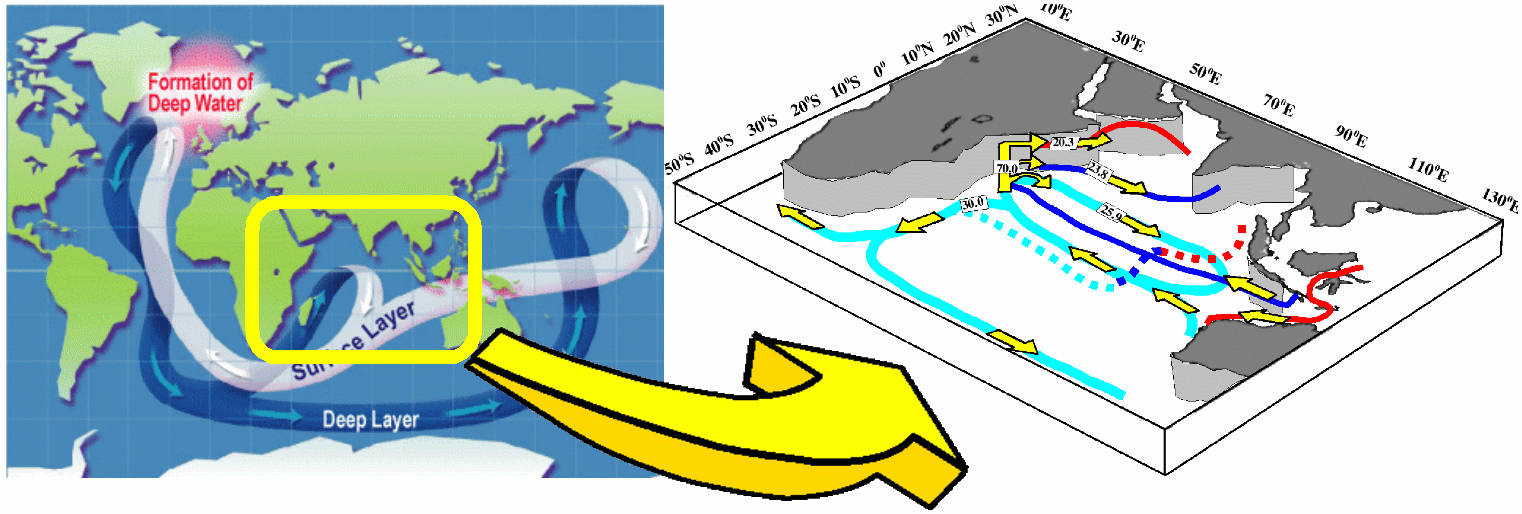| NEWS LETTER 第12号 (2006年 春) |
![]() タロイモショウジョウバエ属(双翅目:ショウジョウバエ科)の繁殖生態
タロイモショウジョウバエ属(双翅目:ショウジョウバエ科)の繁殖生態
およびサトイモ科植物との送粉共生
竹中 宏平 たけなか こうへい
「ハエ」というと不潔なイメージをお持ちの方が多いようだが、花に住むショウジョウバエのことは御存知だろうか。東南アジア一帯に分布するタロイモショウジョウバエ属cristata種群のハエは、サトイモ科植物(通常1種)の花序/果実序を利用して繁殖する一方で、宿主植物の花から花へと花粉を運ぶ送粉者としてはたらく。また、2種のハエが一つの花序を棲み分けることで共存する共宿主ペアというものが知られている。しかし近年、相当数の新種が発見され、既知の繁殖特性に合致しない現象が多数あることがわかってきた。本研究では、ハエの繁殖・植物との送粉共生についての生態調査とともに、DNA分子系統解析を行い、繁殖諸特性ならびに宿主選択の進化について考察した。
本研究によって17新種が発見され、1新種を記載した。中国・マレーシアおよびインドネシアにおける観察・実験から、これらのハエは生活史の大半を特定の宿主植物に依存する一方で、最も有効な送粉者としてはたらき、宿主植物の有性繁殖に不可欠な存在であると結論づけられた。また、共宿主ペアを欠いた宿主植物の独占的な利用や、棲み分けを伴わない共宿主ペアの存在など、新たな知見が得られた。ハエの訪花行動と生活史は、利用する宿主植物の開花・結実スケジュールに密接に対応しており、本種群のハエとその宿主植物は送粉共生を通じて密接に共進化してきたことが強く示唆された。
分子系統解析の結果から、繁殖特性の分化は本種群の基部で進化したことが示唆された。本種群以外の本属のハエがタロイモ属を利用することなどを考慮すると、まず本種群の祖先種あるいは複数の種群の祖先種でタロイモ属への宿主選択が進化し、その後複数の系統でクワズイモ属への宿主選択が進化したと考えられた。
タロイモショウジョウバエ属は、現存する生物多様性を生みだした昆虫と植物の送粉共生の進化を考える上で重要なモデル系となると思われる。
![]() Pathways and effects of the ITF in the Indian Ocean
Pathways and effects of the ITF in the Indian Ocean
Vinu K. V. ビニュー
Indonesian Throughflow (ITF) is a system of currents flowing from the
Pacific to the Indian Ocean via Indonesian Straits. The ITF is the upper
(warm) branch of the Global Conveyor Belt, while much less is known on
its pathways within the Indian Ocean, whose understanding is necessary,
to find the impact of the ITF in the Indian Ocean climate as well as the
response of the conveyor belt in long term climate change. This research
is focused on the detailed three dimensional trajectories of the ITF in
the Indian Ocean and to categorize its impact on the Indian Ocean climatology.
The 3-Dimensional pathways of the ITF in the Indian Ocean are identified using an OGCM, with a combined set of tools (1) Lagrangian particle trajectories, (2) passive tracers and (3) active tracers (temperature and salinity). The Lagrangian particles suggest that at the entrance region the surface ITF (< 60m) subducts off-northwestern coast of Australia (releasing ~40 Wm-2), and then travels across the Indian Ocean along the thermocline depths. The subsurface (> 60m) ITF more directly departs westward and crosses the Indian Ocean. Using the passive tracers, which are mixed vertically under convection as well as horizontally due to diffusion, the ITF is shown to undergo vigorous mixing as soon as it enters the Indian Ocean and modifies its upper T-S characteristics.
Upon reaching the western boundary, more than 70% of the ITF turn northward and reroutes into three distinct depth ranges, owing to the seasonal reversal of the Somali region, as Route-1 (26%): across the Indian Ocean just to the south of the equator (200m-300m), Route-2 (24%): across the Indian Ocean to the north of the equator (100m-200m) and Route-3 (20%): upwells in the Somali region and spreads all over the surface of the northern Indian Ocean. Route-3 dominates during summer monsoon (Apr-Oct) while Route-2 dominates during winter monsoon (Nov-Mar).
The effects of the ITF on the temperature and salinity are mainly accompanied with the major pathways shown by the Lagrangian particles and the passive tracers. The direct effect of the ITF is responsible for a warming (~30C) and freshening (~0.2 psu) of the thermocline depths (100 m) along the main stream (100S to 200S).

Figure: Schematic view of the ITF spreading pathways in the Indian Ocean
| 17年度3月に新博士を排出し、本COEのリサーチアシスタントとして貢献してもらった竹中、Vinuの両君に最新の成果を報告させた。両君を含む新博士の活躍を祈る。 |